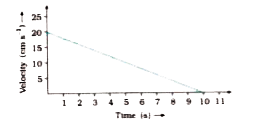The velocity -time graph of a ball of mass 20 g moving along a straight line on a long table is given in

How much force does the table exert on the ball to bring it to rest?Solution in Gujrati
The initial velocity of the ball is 20 cm s−1. Due to the friction force exerted by the table, the velocity of the ball decreases down to zero in 10 s. Thus, u = 20 cm S−1, -Ocm s−1 " and t = 10 s. Since the velocity-time graph is a straight line. It is clear that the ball moves with a constant acceleration. The acceleration a is
a=v−ut
=-2 cm s−2 s−2
The force exerted on the ball F is
F=ma
=(201000)kg×(−0.02ms−2) The negative sign implies that the frictional force exerted by the table is opposite to the direction of motion of the ball.
Topper's Solved these Questions
- FORCE AND LAWS OF MOTIONBOOK - KUMAR PRAKASHANCHAPTER - FORCE AND LAWS OF MOTIONEXERCISE - Additional solved numericals
9 Videos
- FORCE AND LAWS OF MOTIONBOOK - KUMAR PRAKASHANCHAPTER - FORCE AND LAWS OF MOTIONEXERCISE - Additional Exercise
4 Videos
- FORCE AND LAWS OF MOTIONBOOK - KUMAR PRAKASHANCHAPTER - FORCE AND LAWS OF MOTIONEXERCISE - QUESTIONS AND ANSWERS(Answer the following questions in detail:)
4 Videos
- GRAVITATIONBOOK - KUMAR PRAKASHANCHAPTER - GRAVITATIONEXERCISE - ACTIVITY 10.4
2 Videos
Similar Questions
A truck starts from rest and rolls down a hill with a constant acceleration .It travels a distance of 400 m in 20 ms.Find its acceleration 6 tones (Hint:1 tonne =1000 kg)
View SolutionThe following is the distance-time table of an object in motion:

(a)What conclusion can you draw about the acceleration ?Is it constant. Increasing decreasing ir zero? (b)What do you infer about the force acting on the object?
View Solution(a)Define :Force
(b)The velocity -time graph of a car of mass 1000 kg is given below:
(i)When is the maximum force acting on the car>Why?
(ii)What is the retarding force?
View SolutionTake an empty plastic bottle . Close the mouth of the bottle with an airtight stopper . Put it in a bucket filled with watere . The bottle floats .
Push the bottle into the water. You feel an upward push. Try to push it further down. You will find it difficult to push deeper and deeper. Water exerts a force on the bottle in upward direction. Now release the bottle. It bounces back to the surface.
Does the force due to the gravitational attraction of the earth act on this bottle? If so, why doesn't the bottle stay immersed in water after it is released ?
View SolutionA horizontal force of 20 N i sapplied to a block of mass 4 kg resting on a rough horiozontal table. If the blcok does not move on the table, how much fricrtional force the table is applying on the blockgt What can be said about the coefficient of static friction between the block and the table? Take g=m/s^2 .
View SolutionThe velocity time graph of a ball of mass 20g moving along a straight line on a long table is given in (figure) How much force does the table exert on the ball to bring it to rest?
View SolutionThe speed time graph of a ball of mass 30g moving along a straight line is shown in (figure). Calculate the opposing force that brings the ball to rest.
View Solutionएक लंबी मेज पर सीधी रेखा में जा रही 20g द्रव्यमान की गेंद का वेग-समय ग्राफ में दिया गया है। गेंद को विरामावस्था में लाने के लिए मेज द्वारा कितना बल लगेगा?

View SolutionA ball of mass 250 g moving with 20 m/s strikes a vertical wall and rebounds along the same line with a velocity of 15 m/s. If the time of contact is 0.1 s, the force exerted by the wall on the ball is
View SolutionThe velocity-time graph of a 20 kg mass ball going in a straight line on a long table is given in the figure. How much force will be used by the table to bring the ball to rest?
View SolutionThe velocity time graph of a ball of mass 20g moving along a straight line on a long table is given in (figure) How much force does the table exert on the ball to bring it to rest?
View Solutionतीन समरूप गेंद A,B तथा C को एक टेबल पर सरल रेखा के अनुदिश रखा गया है। B व C प्रारम्भ में विराम में है

A गेंद चाल 10ms−1 से गेंद B पर सीधे संघट्ट करती है सभी संघट्टों (प्रत्यास्थ मानने पर ) के पश्चात A तथा B विराम में हो जाती है तथा C का प्राप्त वेग है
View Solutionचार चिकनी स्टील की समान द्रव्यमान के गेंदे विरामावस्था में है तथा घर्षण रहित एक सीधी रेखा के अनुदिश गति करने हेतु स्वतंत्र है प्रथम गेंद को 0.4 मी/से वेग दिया जाता है , तो यह दूसरी गेंद के साथ प्रत्यक्ष संघट्ट करती है ठीक इसी प्रकार दूसरी गेंद तीसरी गेंद से टकराती है तथा तीसरी गेंद चौथी गेंद से टकराती है अंतिम गेंद का वेग होगा
View Solutionটেবিলের ওপর 10 Kg ভরের একটি ব্লক আছে | টেবিলের ওপর ব্লক কত বল প্রয়োগ করছে ? টেবিলের ওপর ব্লকটি স্থির থাকে কেন ? টেবিলের ওপর ব্লকটি কত চাপ প্রয়োগ করে? [টেবিল ও ব্লকের সংযোগতলের ক্ষেত্রফল 0.25m2]
View SolutionA horizontal force of 20 N is applied to a block of mass 4 kg resting on a rough horizontal table. If the block does not move on the table, how much frictional force the table is applying on the block. What can be said about the coefficient of static friction between the block and the table? Take g=10m/s^2 .
View Solution
